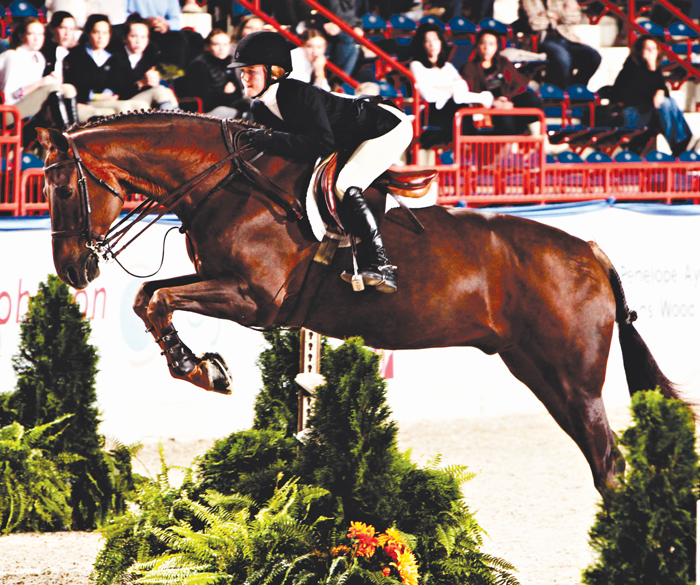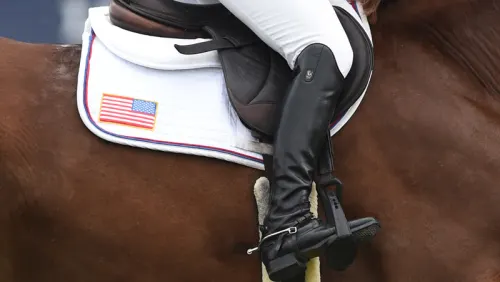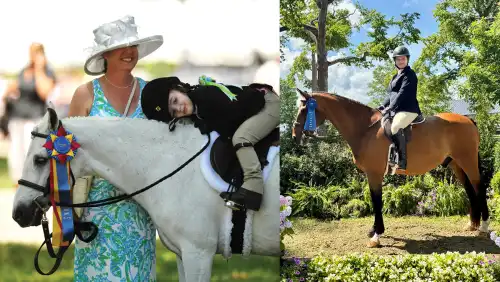In everything we do, we need to make sure we’re continuing to challenge our riders.
As the U.S. Hunter Jumper Association convention approaches in early December, several recent Chronicle articles have given all of us in the hunter/ jumper world something to think about.
Many people complain about the issues Shelley Campf, Leo Conroy, George Morris and Ron Danta have brought up in their articles.
Shelley Campf and Leo Conroy certainly hit the nail on the head about the judging. Although I’m not a proponent of standardizing judging, I feel that there should be more guidelines to hunter and equitation judging. For instance, the equitation classes have a mandatory 4 points off for a rail down regardless of whose fault it was, horse or rider. Of course more can be subtracted, but at least there is a guideline.
Exhibitors must also know that you have to see the round from the same vantage point that the judges do. Judges, on the whole, are very fair. I’m still a believer that two judges sitting together is the best system. But Shelley hit it on the nose: We, as trainers, must tell the riders the truth about their rounds!
Anyone who has participated in any other sports, such as basketball, football, hockey or baseball, knows that there is constant complaining about the refereeing. So just as judging can be an issue, it’s something we deal with in most of our sports in this country.
We need to analyze each situation that’s been discussed and ask ourselves if we are being too self-centered. No matter which hat we’re wearing—show manager, trainer, rider, owner or judge—we need to work together and come up with solutions.
First and foremost, we must keep raising the bar, not lowering the bar. Lowering the bar is the easiest solution but not always the best. I’ve written in my articles for the past six years that our country has started lowering the bar in all we do, and we think too much of “I” instead of what is best for the majority.
What can make our business better? How can we make the cream of the crop rise to the top? How can we give everyone goals from their first short stirrup class to the international hunter derbies to the Olympics?
Raising the bar is the only way to keep the hunters alive. Bigger goals give owners something to strive for and make them want to buy horses for professionals to ride. No matter how we fit into the picture, we must keep our eye on the ball.
Keep The Standards High
One of the best aspects of the Pennsylvania National this year was in the high performance hunter classes. Blake Alder, the course designer, made the jumps 4’3″. The rounds were spectacular!
ADVERTISEMENT
Twenty years ago we had superstar horses like Protocol, Whadyasay, Another March, Super Flash, Ruxton, Bittersweet, Gabriel, San Felipe, Sign The Card, Gozzi, Touch The Sun, and All The Gold, to name just a few. Owners, trainers and fans ran to the ring at the big shows to watch the regular working (now the high performance) hunters go. The jumps were big, and the courses difficult, and we had a lot of horses showing in that division. It was an exciting division to watch.
But that division has been shrinking, both in number of horses and in excitement. Why?
Everyone showing, rich or poor, wants to win enough prize money to at least pay their stall and entry fees at shows. Years ago, the prize money in the hunters and the jumpers was about the same. But the jumpers kept raising the bar, and the hunter group allowed the money-won to remain the same, even as showing costs escalated.
Why, as an owner, would you want to stay in it and support a horse in the high performance division if it’s a losing proposition financially? Why should owners buy horses for professionals if they cannot compete for more money?
Raising the prize money is good for all exhibitors, but some of the show managers are fighting it. The decline in professional divisions has been going on for 10 years, not just the past two years that money-won has come into play. Wake up: There has to be a better distinction between A and AA shows.
A Ladder Up The Levels
And, in order to raise the standards at the top levels, we need to develop better stepping stones to those levels. The good A and B shows need to come back. Lowering the heights in the AA rated divisions is not the answer.
Years ago, when the hunter divisions were strong and healthy, we used each level of show to learn, develop and to strive for the next level. Now, it seems like there is a division for every rider, even at the best shows. We need to keep the best shows for the cream of the crop and better utilize the other levels of shows as preparation for them.
Every show in the country can’t be everything to everyone. I’m also concerned about the new rule proposal to change the children’s and adult amateur division specifications to be the same across the country. Every zone is different, and competitors’ needs are all different across the country.
It’s all worked well; why are we changing it? Should we put all the zone shows out of business? I think not. Again, levels: Be excited about being the best in your zone. Move up if you want to compete for Horse Of The Year awards.
Don’t Build Down
Keeping the standards high also applies to derby classes. Ron Danta and George Morris both wrote excellent articles about the derbies. Jumps for derby classes need to be different—it is a different class. It’s not for every horse, but it should be everyone’s goal.
ADVERTISEMENT
The derbies give riders the ability to learn to ride different types of courses. Riders need to learn what a true handy class is all about. We put the handy classes in all the divisions to test riding skills and make better riders.
That is what the derbies are all about. They are for horses and riders to test the waters and step up to the plate, not to run or whine because they are harder and different. Again, raise the bar. Make the course designers be inventive, and put the riders and horses to the test.
Building down benefits no one. In the 3’6″ classes, the jumps need to be 3’6″—not 3’3″ or 3’5″. I cannot emphasize this enough. The high performance division—over 3’9″ and 4′ to 4’6″ at the best shows—is supposed to be the top of our sport, so the courses need to reflect that.
A Level Playing Field
I wrote in my last article about getting rid of the ASPCA Maclay regional qualifiers. This year, they have taken almost everyone who competed from each region to come up with 200 riders for the final. Talk about watering down the standards. Is that competition?
The Pessoa/USEF Medal Finals were so well done this year. The judging, the course and the competition itself were well worth the effort. Everyone has the same chance on that day. Schaefer Raposa was amazing throughout all of the phases. She is a hard worker and comes from two hard working parents who helped her reach her goal. Speaking of hard working, hats off to trainer Andre Dignelli and his team at Heritage Farm for their many accomplishments that day.

“The USEF Medal Finals were so well done this year,” said Susie Schoellkopf. “Schaefer Raopsa was amazing throughout all of the phases.” Photo by Al Cook
In the Medal Finals, perhaps Round 1 could be on Saturday, and the course a little softer for the ones who are not there to win, but to get their feet wet and get the feel of it all and the experience for the coming years. We don’t want to discourage the inexperienced riders, but you can’t build to protect weaker riders and separate 230-plus riders, and many have qualified over very simple courses. We all know it’s a long day, but there is nothing like the excitement that enters that arena from the course walk to the final pinning.
So why can’t the ASPCA Maclay Finals run the same way? The regional qualifiers are expensive for riders and trainers. And is it fair to other shows that the competitions that host regionals have the advantage of that captive audience? All of you parents and trainers who emailed me after the last article on this subject need to speak out and let the powers that be know that we no longer need the regional qualifiers or the expense and wear and tear on the horses and riders.
Susie Schoellkopf, of Buffalo, N.Y., is an active R-rated judge for hunters and equitation. She was a successful hunter rider and now owns and manages SBS Farms and serves as the executive director of the Buffalo Therapeutic Riding Center. She is a member of several U.S. Equestrian Federation committees and a founder of the Horsemen’s Advisory Council. Susie’s first Chronicle column was published in November 2002.
If you enjoyed this article and would like to read more like it, consider subscribing. “Let’s Raise the Bar” ran in the November 7, 2011, issue. Check out the table of contents to see what great stories are in the magazine this week.















